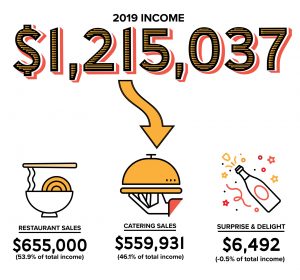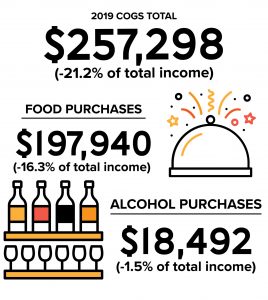
I have always thought to myself that the version of Top Chef that I would want to watch would be chef-owners plunging a toilet, cleaning an overflowing grease trap, balancing a balance sheet, and running payroll as fast as they could — a decathlon of all the administrative bullshit,” says Irene Li, the chef and owner of Mei Mei, a Chinese-American restaurant in Boston. “And obviously, people would be bored to death by that show, but that’s what it really is.”
These days, Li spends a lot of her time thinking about what it takes to keep a restaurant like hers running. In 2016, she was the recipient of an Eater Young Gun award; she’s been a Zagat 30 Under 30 winner, and a six-time James Beard Rising Star Chef semifinalist. That said, she kind of fell into the industry and comes by her genuine enthusiasm for “all the administrative bullshit” honestly.
In the early days at Mei Mei, success was measured by having enough dumplings to get through the day and confirming that the bank account wasn’t empty. Today, every single staff member, from the dishwasher to the line cook, can interpret and speak to the restaurant’s entire profit-and-loss statement because, for two years now, Mei Mei has been opening its books to its staff. This means all staff are able to see every line item associated with money coming in the door and all of the expenses the restaurant takes on — from paying its employees to keeping the lights on. Not only that, each employee actually plays a hand in working to move the bottom line, working on teams tasked with the goal of reducing costs and increasing profits for the business. If the team wants to research and vet new vendors, they have that power. If they want to change the menu prices for a fixed period of time, they’re able to do that too.
In the three years since implementing this practice, Li says she’s seen a measurable difference. The line cook who once questioned Li about the $9 price attached to the Double Awesome menu item, an oozy egg sandwich, can now speak to all of the other costs — the things beyond the eggs, the pesto, and the scallion pancake breading — that they wouldn’t have known to consider before. Because there’s a staff member who called the electric company for refunds when the power went out, one who negotiated for better alarm fees, and another who put in the work to source a cheaper linen provider, there’s an understanding of the full picture of what goes on at the restaurant. As Li puts it, “There’s buy-in because their fingerprints are there.”
Now, it’s no longer enough for Li to share the nitty-gritty financial info with her team. She wants the public to understand it, too.
“The lack of willingness to talk about finances in this industry is holding us back,” says Li. “Culturally, we don’t talk about money at all, and my experience, even with other restaurant owners who I’m really friendly with, is that we’ll talk about all kinds of stuff. HR drama, health inspections — warts and all — but we definitely don’t talk about money. I feel like that is the last barrier that we have to break down in order to really all get on the same page and all figure out how to do a better job.”
Armed with the blessing of her most trusted friends and family, and a lot of nervous “wows,” Li decided that 2020 was the year to start the conversation. So, in the middle of the restaurant, as the Friday dinner crowd was beginning to pick up, we sat down to review the full profit-and-loss statement for Mei Mei for 2019 — something that any diner will soon be able to do.
What exactly are we looking at here?
Profit-and-loss statements (P&Ls) offer a record of a business’s profits and losses over a defined period of time. Essentially, the larger formula you’re looking at is sales – expenditure = profit. When we opened up Li’s P&L, she explained that there are four larger buckets that all of the many line items can be sorted into: income, cost of goods sold (COGS), direct labor, and finally, pages and pages of overheads.
For a restaurant, there are a few goal ratios associated with the major expense categories. Ideally, most operators aim to see COGS and direct labor together at 60 percent (at Mei Mei they target 20 percent and 40 percent, accordingly) and other expenses at 30 percent, leaving you with 10 percent profit. She then explained that independently owned restaurants most often hang out in the 4 to 6 percent range for profit. Don’t worry — there won’t be a quiz.
Businesses are required by law to pull a P&L annually. Most restaurants look at theirs quarterly. At Mei Mei, the entire staff digs in every four weeks.
At Mei Mei, the catering line item includes traditional drop-off catering, weddings, staff-led cooking classes, and restaurant buy-outs. Historically, Li has seen this line item trend upward over the past few years, which she says is an argument for doing more catering in 2020.
Surprise & delight — easily the most objectively “fun” line item name on the document — covers the $40 worth of product (nonalcoholic) that can be given away at each shift. “Sometimes it’s for when we need to fix something. Sometimes it’s for someone who had a hard time choosing between two dumplings, and we just let them have both. It’s for first-time customers we want to wow, and it’s for that person that comes in soaking wet because they didn’t have an umbrella and could really use a hot tea and a free brownie,” Li says. In 2020, Li actually wants to see this expenditure grow, and is now requiring staff to note what was doled out at the end of each shift.


Enjoyed reading this, very good stuff, regards.
Comments are closed.